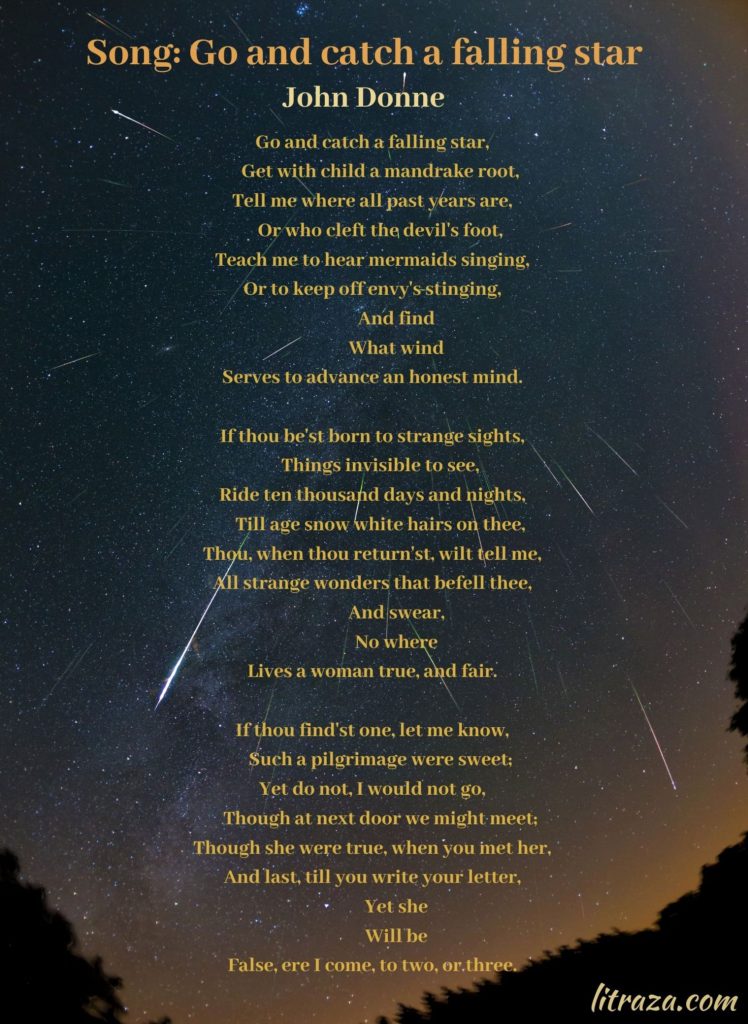Introduction
Go and Catch a Falling Star by John Donne is a song full of satire and cynicism. This song, first published posthumously in 1633, revolves around the popular theme of his era, namely, the infidelity of women. It echoes what Shakespeare said in Hamlet: “Frailty, thy name is woman!” Go and Catch a Falling Star by John Donne is full of poetic devices and artistic beauty. Therefore, the poem remains a part of the English literature syllabi of various educational institutes. Since John Donne has a reputation as a poet practising conceits in his poetry, the readers find his works complex. This song, however, does not contain as complex metaphors as the other works of John Donne. Still, it demands a good deal of prior knowledge of certain myths and beliefs. This article will better your comprehension of Go and Catch a Falling Star by John Donne.
John Donne – A Brief Biography
Born on January 22, 1572, John Donne was a prominent poet, famous scholar, brave soldier, and cleric. His family was one of those who maintained allegiance with the Catholic Church instead of joining the Church of England after the Reformation. John Donne spent many years in poverty because of his taste for womanizing, literature, and travelling. He married Anne More in 1601 and they had twelve children.
John Donne was one of the representative metaphysical poets. He had exceptional prowess in employing conceits, or extended metaphors, in his works. Critics and aesthetes admire unanimously his ability to juxtapose heterogeneous ideas in a single metaphor. Owing to his experiments with form and poetic devices, Donne’s works differ from those of conventional Elizabethan poets. Love, sensuality, eroticism, society, and religion were Donne’s favourite themes. John Donne died on March 31, 1631.
Text of the Poem Go and Catch a Falling Star by John Donne

Summary of the Poem Go and Catch a Falling Star by John Donne
Introduction
Go and Catch a Falling Star by John Donne is an expression of the poet’s idea that women are not constant. It was a popular belief and the subject of many artistic works at that time. In this sense, one may say that the theme of the poem is misogynistic. Donne addresses a passive listener and asks him to do certain impossible things. He believes that finding a woman who is both beautiful and faithful is as difficult as the tasks he mentions.
Stanza 1
This song starts with startling demands by the poet of the listener. John Donne asks the listener to go and catch a falling star. He challenges him to impregnate a mandrake root. Donne tells the listener to find out where the past years go. He directs him to discover who split the devil’s foot. The poet requires him to teach him how to listen to the song of a mermaid. Donne urges the listener to train him to resist envy. He desires to know if there is a wind that may help an honest person make progress in life.
Stanza 2
John Donne furthers his argument. He says that a person with a prophetic eye to see ethereal things may go on a pilgrimage of ages. During this pilgrimage, he may grow very old. On his return, he would have many wonderful things to tell. But he would not be able to claim that he found a woman that were beautiful and faithful.
Stanza 3
John Donne asks the listener to tell him if he knows the whereabouts of a pretty, loyal woman. To him, it would be worth travelling to see such a woman. Still, he says that he would not go out to see this woman even if she lives next door. He tells the listener that the woman may be faithful when he first met her. But by the time he writes her a letter expressing his love, she must have betrayed two or three men.
Conclusion
Go and Catch a Falling Star by John Donne is a rhetoric decrying the infidelity of women. John Donne’s tone reflects scorn for women at large. In modern times, this song may have caused an uproar from feminists. As far as the artistic worth is concerned, the song contains references to myths and mysteries. As usual, John Donne’s use of metaphor in Go and Catch a Falling Star is impeccable.
Analysis of the Poem Go and Catch a Falling Star by John Donne
Theme
Go and Catch a Falling Star by John Donne revolves around a misogynistic concept of the Renaissance that women are faithless. Donne mentions some impossible tasks. These tasks relate to common human observations and beliefs. A person may see a falling star, but he cannot guess where it falls. Therefore, it is impossible to catch it. Mandrake root is famous for its medicinal quality of creating fertility in humans. In its shape, it looks like a woman. But it cannot give birth to a child. So, no one can impregnate it. Time moves constantly. The present becomes the past. But no one can track the path of time and find out where it goes after it passes. The devil’s cloven foot relates to a Christian belief. But who cleft it is a mystery. Similarly, sailors believe in the mermaid’s song, but no one may claim to ever have heard it. Donne implies that finding a faithful woman is as impossible as these tasks are. He says that even a search of a lifetime to find a faithful woman would be a failure.
Mystery
Go and Catch a Falling Star by John Donne is full of mysterious references. A falling star is a mystery. One cannot say why, when, and how a star falls. To catch it, one must know where it is going to fall. One cannot say whether it falls on the earth or dissolves in the sky. This mystery about the falling star indicates the mysterious nature of a woman. She may be a star in the sky. But there is always a chance of her falling from the sky without any apparent reason. At such moments, no one can catch her and save her from falling to the ground.
The movement of time is another mystery. No one can tell where the time goes once it passes. It may be a reference to the fickleness of a woman’s nature. She may slip out of life unknowingly as time passes stealthily.
Myths
Mandrake root has myths associations. People made talismans of mandrake root to cure infertility. This root resembles a woman in shape. Donne asks his listener to impregnate this root that looks like a woman and, as people believed, could cure infertility. It is impossible. Donne incorporates this myth to mean that neither medicine nor magic can cure a woman of her infidelity.

A mermaid’s song is another myth. It is a belief that it lures sailors to death. But no sailor has ever claimed to have heard of a mermaid’s song. It is a satire on a woman’s fidelity. Donne opines that the instances of a woman’s faithfulness are as mythical as a mermaid’s song.
The myth of the devil’s cloven foot shows that it is as difficult to find a person with proof of a woman’s fidelity as is to find the person who cleaved the devil’s foot.
Magic
Go and Catch a Falling Star by John Donne contains references to magic. The second stanza is all about magic. At the same time, it is a more direct satire of a woman. Donne says that a person born with magical qualities may travel the whole life to find a faithful woman. He may use his prophetic vision in his quest. But the result is not going to be favourable. He may be able to tell of many wonders he came across during his journey of life. But he will not be able to tell of a constant woman.
Conclusion
Go and Catch a Falling Star is a forceful expression of the poet’s, and even society’s, views about women. Considering the age and mindset of the age, the song is an artistic accentuation of women’s infidelity. However, in modern times, with the advent of feminism, the song may be interpreted differently. The song shows John Donne as a staunch misogynist.
Attention
Excellent notes for preparation of the poem, When I am Dead, my Dearest by Christina Rossetti



